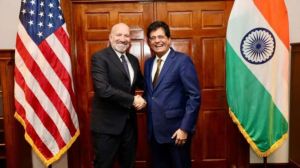Budget Speech of Finance Minister,31 December 2019
31st December 2019,Tuesday,is a happy occasion for I,6783-4592-3867-4502,to present the Union Budget for 2020....
Honourable Speaker,
31st December 2019,Tuesday,is a happy occasion for I,6783-4592-3867-4502,to present the Union Budget for 2020. Since reformist elements in Congress and BJP formed an alliance and collectively fought the Parliamentary elections in May 2019,we have trounced the Leftist opposition and have successively implemented our 200-day reform blueprint. There are many firsts today. For all official purposes,we have switched from using names and surnames to 16-digit identity numbers. Agricultures share in GDP is now 10 per cent,though 65 per cent of the population still ostensibly earns a living from the rural sector. Consequently,economic growth is still a function of the monsoon,and will become even more so because of a reason I will later mention. Though the Indian Meteorological Department has been wound up and monsoon forecasts outsourced to the joint venture between Indian Institute of Science and NASA,we still do not have an accurate handle on agricultural production towards the end of February (which is when the budget used to be presented) and 31st March (which is when the fiscal year used to end earlier). Discarding the colonial legacy,the fiscal year has now become the calendar year and budget presentation will henceforth be on 31st December. This is also the first time in the history of independent India that there is not a single Member of Parliament or Minister born before 15th August 1947. This has enabled the reform party to shrug off colonial hangovers and we have also opted out of the non-aligned movement (NAM). As the President said in the inaugural address to Parliament,It is better to be maligned than non-aligned.
I do not need to repeat before the House the outstanding economic successes in the last decade. Real GDP growth averaged 9.5 per cent during the 12th Plan (2012-17) and has so far been 10.5 per cent in the first two years of the 13th Plan. The concept of five-year planning periods is also a historical legacy and will eventually be scrapped. We have made a beginning by scrapping the Planning Commission. It was always an extra-Constitutional body,set up through executive order in 1950. The Second Constitution Review Commission made several recommendations,the thrust being that we should remove deviations from the original 1950 Constitution. In the process of implementing these recommendations,the Planning Commission has been disbanded and all transfers to the 51 States and 603 local bodies will now be made in accordance with the recommendations of the 15th Finance Commission.
In this connection,I should mention former Pakistan too. With Balochistan,North West Frontier Province and FATA integrated with Afghanistan and Kashmir a free economic zone together with Gilgit-Baltistan,Punjab and Sindh have applied for integration with India. The Constitution isnt clear on what should be done in situations like this. Nor is this an issue the Second Constitution Review Commission examined. While this decision is pending,neither Punjab nor Sindh in former Pakistan have witnessed the kind of water reforms and irrigation revolution India has undergone in the last decade. If these regions are integrated with India,the economy will be subjected even more to monsoon vagaries.
As a result of the water and irrigation revolutions,no rice is grown any more in the former Green Revolution areas of Punjab,Haryana and Western UP. More accurately,basmati rice and Durum wheat grown there is only for export purposes. As members are aware,we have also scrapped the PDS (public distribution system). The Food Corporation of India (FCI) is only entrusted with procurement for buffer stock purposes and this procurement of rice,wheat and coarse foodgrains now occurs in Eastern UP,West Bengal,Orissa,Chhattisgarh and Assam. However,since Indian agriculture has diversified and commercialised into fruits and vegetables,livestock and fishery,only 25 per cent of Indias value of domestic agricultural production now consists of food-grains. 30 per cent of domestic demand for food-grains is now imported,for both human and animal purposes. The population has just crossed 1.4 billion. That per capita income growth of 8 per cent during the 12th Plan and 9 per cent in the first two years of the 13th Plan has transformed the lives of the population.
Growth has also meant that the rupee has appreciated. Indias exports have done well,though India still accounts for only 2.5 per cent of world exports if only goods are included and 3.5 per cent if both goods and services are included. Services now account for 65 per cent of GDP. Though industry still accounts for only 25 per cent of GDP and manufacturing for 18 per cent,because services have done so much better,much of that growth in exports has been driven by manufacturing and in sectors like garments,basic metals,chemicals,leather,machinery and equipment,electrical machinery and motor vehicles,India has become part of global supply chains and a major location for production. This kind of manufacturing growth explains why FDI inflows in 2019 have amounted to 75 billion US dollars. FDI outflows from India,driven primarily by mergers and acquisitions,have amounted to 35 billion in 2019. The per capita income is now 2077 US dollars and the Indian economy has just broken into the 3 trillion US dollar league. Against the US dollar,the rupee has appreciated to 30 rupees to a dollar.
The Leftist opposition criticised us that there was nothing in this growth for the poor. Nothing can be further from the truth. Using the conventional poverty line,the percentage of population below the poverty line has dropped from 20 per cent in 2008-09 to 10 per cent in 2018-19,the last year for which we have large-sample NSS data. The Leftist opposition used a 5 US$ per day poverty line to suggest that 78 per cent of the Indian population was still poor. This is neither here nor there and our government refuses to set up a Poverty Commission to examine the issue. As it is,we have reduced the number of Central government ministries and ministers to a maximum of 10 and there is ban on establishing new Commissions,unless approved by a two-thirds majority in Parliament. We cannot of course do anything about the second Liberhan Commission on Ayodhya. This was set up in 2011 and is yet to submit a report. We are told that a report might be ready in 2028.
What is obvious is that there has been an explosion in consumption growth and not just among the elite. There are 1 billion mobile connections and handsets have become free. A new CII report says that the consuming class,which doesnt consist only of middle and upper income groups,now numbers 850 million. The adult literacy rate is 85 per cent,with a substantial amount of adult illiteracy still in the pipeline. For example,if one considers the literacy rate among those who are below the age of 24 years,it happens to be 95 per cent. The enrolment ratio in tertiary education has increased to 15 per cent. There have been some improvements in health indicators too. The infant mortality rate has decreased to 35 per thousand. UNDPs Human Development Report (HDR) for 2019 shows that,measured by the HDI (Human Development Index),India has just crossed the threshold of 0.800 and has stepped into the high human development category. Therefore,growth has been good for the cause of the poor and for development. This doesnt mean that there is no poverty in India. Among able-bodied poor,such poverty is concentrated in West Bengal,Orissa and Tripura and the Bangladesh government has been complaining that if illegal migration from these parts of India to Bangladesh is not stopped,the Bangladesh government will be forced to erect fences. As it is,one-thirds of Bangladeshs geographical area is threatened by climate change. Unlike other States,the Leftist governments in these three States have resisted reform. The vastly improved economic climate in Gorkhaland,which was separated from West Bengal,shows what is possible if a reform-minded government is in power. Be that as it may,there is poverty in India,among the able-bodied and among those who are disabled and aged. Our government has worked out a deprivation index based on class,caste,gender,education,health and physical infrastructure indicators. This is individual-based and is not based on collective categories. On the basis of this,all subsidies have been replaced by direct and unconditional cash transfers. This explains why the last report by the soon-to-be-wound-up Planning Commission finds that 67.3 per cent of anti-poverty expenditure reaches the target beneficiary.
I have so far refrained from talking about what is usually the staple for all budgets taxes and expenditure. Nothing need be said on taxes. After direct taxes were reformed between 2011 and 2015,there are no longer any exemptions and all rates have been standardised and harmonised at slabs of 10,20 and 30 per cent. There are no surcharges and cesses. Much the same can be said of indirect taxes,reformed between 2013 and 2017. With all local body taxes eliminated,the GST stands at 20 per cent,apportioned 10 per cent to the Centre and 10 per cent to States. On expenditure,salaries,pensions,interest payments and defence expenditure are given to Finance Ministry from outside and all other expenditure comes upwards from the exercise undertaken at district-level. Consequently,there is no need to have this annual budget exercise and this will be the last budget of the present government. Perhaps I should mention that after the 8th Pay Commissions recommendations,all government appointments have become contractual.
I commend this budget to this House.
The writer is Delhi-based Economist





- 01
- 02
- 03
- 04
- 05


























